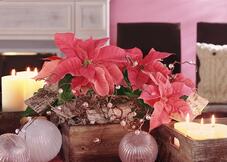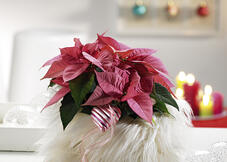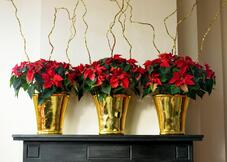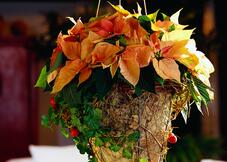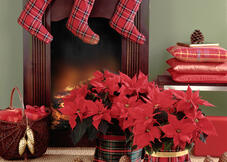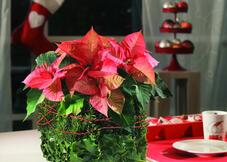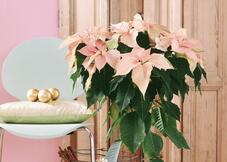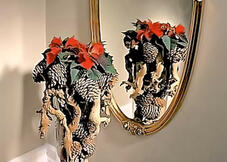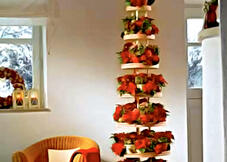Christmas flower
With red, pink or cream colored bracts, the Christmas flower is an absolute must in the run up to the festive season. Here’s how to care for this popular houseplant.
Factsheet
- Growth type
-
- shrub
- Growth height (from)
- from 50 cm to 60 cm
- Growth width (from)
- from 40 cm to 45 cm
- Growth characteristics
-
- upright
- Flower color
-
- green
- yellow
- Flowering time (month)
-
- January
- October to December
- Flower shape
-
- Trumpets
- Leaf color
-
- green
- red
- page format
-
- egg-shaped pointed
- lancéolées
- Sheet properties
-
- evergreen
- Light
-
- scattered light
- Soil type
-
- loamy
- Soil Moisture
-
- moderately dry
- ph value
-
- neutral
- Lime compatibility
-
- lime-tolerant
- Nutrient requirements
-
- moderately nutritious
- Humus
-
- rich in humus
- Decorative or utility value
-
- Leaf ornaments
- Toxicity
-
- highly toxic
- Winter Hardness
-
- frost-sensitive
- Climate zones according to USDA
-
- 10
- Use
-
- Interior greening
- Planters
- Winter garden
- Warm House
- Garden style
-
- Pot garden
The Christmas flower has the botanical name Euphorbia pulcherrima and is also commonly known as the Poinsettia. It is a species of spurge and belongs to the spurge (Euphorbiaceae) family. Locally, the Christmas flower is generally kept as an annual houseplant, although in its original form it is neither annual nor a pot plant. The Christmas flower is actually a persistent, evergreen bush from South America. The star shaped leaves of the plant captivated the botanist Carl Ludwig Willdenow, who gave the plant its botanical designation Euphorbia pulcherrima gab – "the most beautiful of the spurges".
The Christmas flower has only gained notoriety as a houseplant here since the 1950s. Since then, its popularity as grown and grown and, despite its seasonality, the Christmas flower is now the most commonly sold houseplant in the world. A large selection of plants is available during the run up to the festive season in particular.
Caution: Christmas flowers are poisonous! As with other spurge species, the sap of the Poinsettia contains components which are mildly irritant to the skin. Consumption by small pets such as cats, rabbits, birds or hamsters may result in mild symptoms of poisoning. This should be taken into consideration when acquiring and placing the plant in a home and you should wear gloves when repotting and pruning the Christmas flower in order to prevent unnecessary contact with the sap. In general, skin contact is harmless, however the plant sap can induce allergic reactions in sensitive people.

The Christmas flower is a wonder to behold in its native environment in South and Central America: There, it grows to a sweeping, 20 feet tall bush. The compact growth of this unusual pot plant is an artificial result of the chemical inhibitors and also the limited root space in plant pots. The extensively branched, bushy plants generally only grow 20 to 24 inches call and 16 to 18 inches wide. The Christmas flower is available both as a standard and also in miniature form.
The Christmas flower forms large, pointed ovate or lanceolate leaves. Colorful leaves appear in a rosette-shaped arrangement on the shoot tips, which leads to a wide-spread misnomer: The colorful stars, which make the plant a commercial favorite during the Christmas period, are not the plant’s flowers. Rather, these are bracts. In the wild forms of the Christmas flower, the bracts are always red. However, species have been bred in the meantime with cream-white, yellow, pink-colored or variegated bracts. Although, Christmas flowers with blue, silver or golden colored leaves are not of natural origin - they are created with spray colors.

The actual flowers of the Poinsettia are small, yellowish-green formations in the center of the leaf star, which could easily be mistaken for pistils. Lobate-shaped nectar glands are arranged individually or in pairs on the outer edge. The Christmas flower uses these to attract various flying insects in its native tropical environment in order to pollinate the flowers. The flowering period for the pot plant ranges from October to January. Tip: If you are interested in buying a longer lasting Christmas flower, make sure that the small flowers in the center of the bracts are still closed and have not been sprayed with a color.
Christmas flowers like a bright location but not full sunlight. The flowers last significantly longer at 64 to 69 degrees Fahrenheit during the winter than in extremely warm rooms. However, they are sensitive to both extremely high and extremely low temperatures as well as drafts. The temperature requirements are rarely taken into consideration when Christmas flowers are sold in supermarkets and garden centers from November. This often means that the plants drop their leaves shortly after they are sold, and when the first leaves drop, the plant faces a quick demise.
Make sure when purchasing a Christmas flower that it has not been kept in too cold a location, transport it with plenty of insulation and do not place it in a drafty or cold place in your home, so that it retains its red-green beauty for as long as possible. Christmas flowers are particularly sensitive to cold drafts - in such conditions they tend to drop their leaves.

Euphorbia pulcherrima can spend the summer in a bright location out doors, but without direct rays of sunlight, however, as soon as fall begins and the thermometer drops below 50 degrees Fahrenheit, it should be brought back inside. In the fall, the shorter days stimulate renewed flower formation. Place the plant in a spot without artificial light in the evenings for about six weeks, for example, in a hallway or a basement with a window, in order to further stimulate flower formation. It you don’t have that option, cover your Christmas flower in the early afternoon with a large box until the bracts have changed color again.
As the soil of the pot ball of newly purchased Christmas flowers is often low quality and does not properly retain water, it is recommended to repot it at the latest after it has flowered. Cactus soil has proven to be a good substrate, as it stores little moisture and Christmas flower roots, which are sensitive to waterlogging, tolerate frequent watering better than when an extremely humus-rich soil is used.
It is better to water your Christmas flower too little rather than too much, as the Euphorbia pulcherrima does not tolerate waterlogging at all. The houseplant prefers being submerged in water, every seven to ten days, depending on the pot size and humidity. The flower soil can be allowed to dry out a little in between, before the Christmas flower is watered again. Yellow leaves which drop are an indication of roots which are too wet. Drooping leaves, which occur particularly easily in direct rays of sunlight, mean the Christmas flower is too dry. You should always put a saucer under the pot to allow excess water to run off.

In the spring after flowering - from around March - the Christmas flower can be kept almost completely dry for a month. During the growth period from April until the fall, it should once again be given plenty of room temperature water. The ball should be kept constantly moist and may never be allowed to dry out, as this will stunt the growth. The Christmas flower only requires minimal watering in the winter months.
You should give the Christmas flower fertilizer every two weeks from the spring to the fall.
You can repot the Christmas flower annually in the spring or the summer. Use a new pot for this which is only slightly larger than the previous one: In containers which are too large, the Christmas flower does show striking growth and lots of leaves, but it only develops a few flowers and bracts. Conversely, if it is kept like a bonsai with limited root space, it remains compact and - with the correct care - flowers extensively.

After the colored bracts have dropped, the perennial Christmas flower can be easily over-summered with a little care and will display its colorful leaves again in the coming year. For this,prune your Christmas flower back heavily after it blooms and repot it in fresh, permeable substrate.
Christmas flowers are often simply disposed of when they lose their red bracts - but unfairly, as following a few care tips means you can enjoy them for a long time afterwards. Similar to the Christmas cactus (Schlumbergera), the Christmas flower is a short-day plant. It only forms new bracts and flower buds with fewer than twelve hours of daylight. However, artificial light means rooms stay lit for much longer than the Christmas flower requires in order to form flowers. If it is placed in the light for longer than twelve hours, it goes on a blossom strike and only forms green leaves: After all, this late riser needs its beauty sleep.
Gardeners in this country recognize the Christmas flower characteristic whereby its flower formation is triggered by a maximum of twelve hours of light: They cover their greenhouses from October with black film, creating the illusion of a shorter day for the Christmas flower. And voilá - the red stars appear together with the flowers right on time for the festive season. Conversely, this means that their Christmas flowers can also be left to blossom in the middle of summer, if they experiment a little and remove the light correspondingly early.
Tip: If you keep this short-day plant in the dark for 12 to 14 hours a day for about two months from September by covering it with a cardboard box, you stimulate the tropical light relationship and your Christmas flower will bloom again at Christmas.

In addition to the classic red Poinsettia there are now numerous Christmas flowers available in unusual colors. Christmas flowers from the Pincettia series flower from September and come in a wide range of colors, from lush pink to orange and radiant white.

Christmas flowers are best propagated with cuttings. These can be taken continuously when pruning in spring and clipping in the summer. Take 2.76 to 3.94 inch long cuttings and briefly dip the weeping cut end into water to stem the flow. Then place the cuttings in coarse sand mixed with potting soil. The cuttings only take root in temperatures above 72 degrees Fahrenheit - if you aren’t sure, keep the Christmas flower cuttings in a special propagating tray or mini greenhouse with under floor heating.
Yellowed or withering leaves on Christmas flowers are generally caused by a cold draft. Permanently wet soil leads to root rot and gray mold. Cut off affected leaves immediately and remove them carefully to prevent fungal spores spreading further. Aphids like to infest young shoots. Extremely dry air can lead to mealy and scaly bugs.













